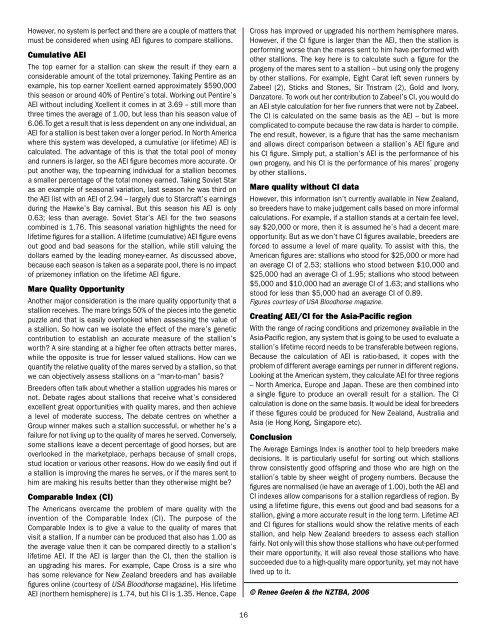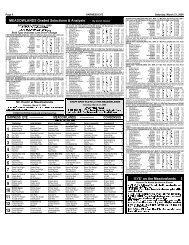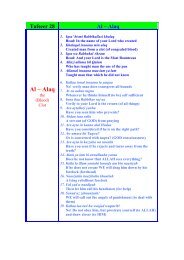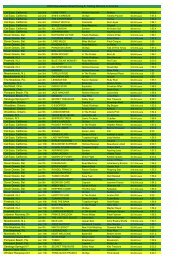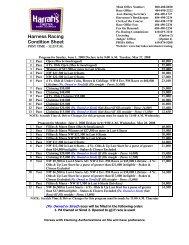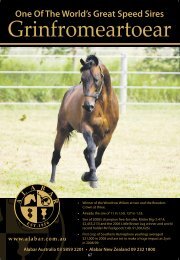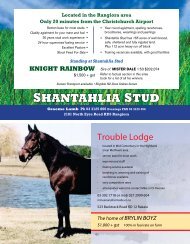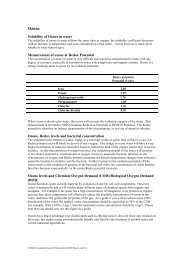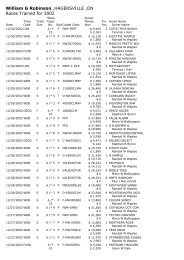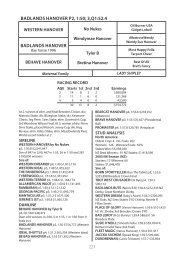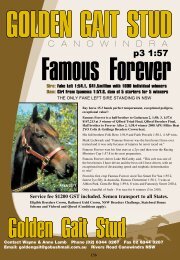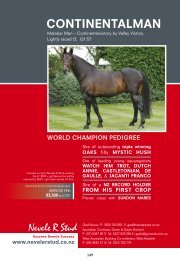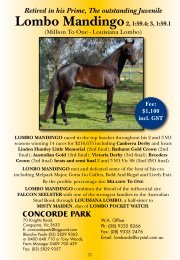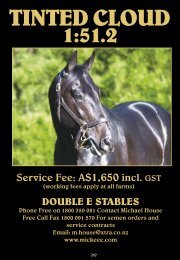Stallions - Harnesslink
Stallions - Harnesslink
Stallions - Harnesslink
You also want an ePaper? Increase the reach of your titles
YUMPU automatically turns print PDFs into web optimized ePapers that Google loves.
However, no system is perfect and there are a couple of matters that<br />
must be considered when using AEI figures to compare stallions.<br />
Cumulative AEI<br />
The top earner for a stallion can skew the result if they earn a<br />
considerable amount of the total prizemoney. Taking Pentire as an<br />
example, his top earner Xcellent earned approximately $590,000<br />
this season or around 40% of Pentire’s total. Working out Pentire’s<br />
AEI without including Xcellent it comes in at 3.69 – still more than<br />
three times the average of 1.00, but less than his season value of<br />
6.06.To get a result that is less dependent on any one individual, an<br />
AEI for a stallion is best taken over a longer period. In North America<br />
where this system was developed, a cumulative (or lifetime) AEI is<br />
calculated. The advantage of this is that the total pool of money<br />
and runners is larger, so the AEI figure becomes more accurate. Or<br />
put another way, the top-earning individual for a stallion becomes<br />
a smaller percentage of the total money earned. Taking Soviet Star<br />
as an example of seasonal variation, last season he was third on<br />
the AEI list with an AEI of 2.94 – largely due to Starcraft’s earnings<br />
during the Hawke’s Bay carnival. But this season his AEI is only<br />
0.63; less than average. Soviet Star’s AEI for the two seasons<br />
combined is 1.76. This seasonal variation highlights the need for<br />
lifetime figures for a stallion. A lifetime (cumulative) AEI figure evens<br />
out good and bad seasons for the stallion, while still valuing the<br />
dollars earned by the leading money-earner. As discussed above,<br />
because each season is taken as a separate pool, there is no impact<br />
of prizemoney inflation on the lifetime AEI figure.<br />
Mare Quality Opportunity<br />
Another major consideration is the mare quality opportunity that a<br />
stallion receives. The mare brings 50% of the pieces into the genetic<br />
puzzle and that is easily overlooked when assessing the value of<br />
a stallion. So how can we isolate the effect of the mare’s genetic<br />
contribution to establish an accurate measure of the stallion’s<br />
worth? A sire standing at a higher fee often attracts better mares,<br />
while the opposite is true for lesser valued stallions. How can we<br />
quantify the relative quality of the mares served by a stallion, so that<br />
we can objectively assess stallions on a “man-to-man” basis?<br />
Breeders often talk about whether a stallion upgrades his mares or<br />
not. Debate rages about stallions that receive what’s considered<br />
excellent great opportunities with quality mares, and then achieve<br />
a level of moderate success. The debate centres on whether a<br />
Group winner makes such a stallion successful, or whether he’s a<br />
failure for not living up to the quality of mares he served. Conversely,<br />
some stallions leave a decent percentage of good horses, but are<br />
overlooked in the marketplace, perhaps because of small crops,<br />
stud location or various other reasons. How do we easily find out if<br />
a stallion is improving the mares he serves, or if the mares sent to<br />
him are making his results better than they otherwise might be?<br />
Comparable Index (CI)<br />
The Americans overcame the problem of mare quality with the<br />
invention of the Comparable Index (CI). The purpose of the<br />
Comparable Index is to give a value to the quality of mares that<br />
visit a stallion. If a number can be produced that also has 1.00 as<br />
the average value then it can be compared directly to a stallion’s<br />
lifetime AEI. If the AEI is larger than the CI, then the stallion is<br />
an upgrading his mares. For example, Cape Cross is a sire who<br />
has some relevance for New Zealand breeders and has available<br />
figures online (courtesy of USA Bloodhorse magazine). His lifetime<br />
AEI (northern hemisphere) is 1.74, but his CI is 1.35. Hence, Cape<br />
16<br />
Cross has improved or upgraded his northern hemisphere mares.<br />
However, if the CI figure is larger than the AEI, then the stallion is<br />
performing worse than the mares sent to him have performed with<br />
other stallions. The key here is to calculate such a figure for the<br />
progeny of the mares sent to a stallion – but using only the progeny<br />
by other stallions. For example, Eight Carat left seven runners by<br />
Zabeel (2), Sticks and Stones, Sir Tristram (2), Gold and Ivory,<br />
Danzatore. To work out her contribution to Zabeel’s CI, you would do<br />
an AEI style calculation for her five runners that were not by Zabeel.<br />
The CI is calculated on the same basis as the AEI – but is more<br />
complicated to compute because the raw data is harder to compile.<br />
The end result, however, is a figure that has the same mechanism<br />
and allows direct comparison between a stallion’s AEI figure and<br />
his CI figure. Simply put, a stallion’s AEI is the performance of his<br />
own progeny, and his CI is the performance of his mares’ progeny<br />
by other stallions.<br />
Mare quality without CI data<br />
However, this information isn’t currently available in New Zealand,<br />
so breeders have to make judgement calls based on more informal<br />
calculations. For example, if a stallion stands at a certain fee level,<br />
say $20,000 or more, then it is assumed he’s had a decent mare<br />
opportunity. But as we don’t have CI figures available, breeders are<br />
forced to assume a level of mare quality. To assist with this, the<br />
American figures are: stallions who stood for $25,000 or more had<br />
an average CI of 2.53; stallions who stood between $10,000 and<br />
$25,000 had an average CI of 1.95; stallions who stood between<br />
$5,000 and $10,000 had an average CI of 1.63; and stallions who<br />
stood for less than $5,000 had an average CI of 0.89.<br />
Figures courtesy of USA Bloodhorse magazine.<br />
Creating AEI/CI for the Asia-Pacific region<br />
With the range of racing conditions and prizemoney available in the<br />
Asia-Pacific region, any system that is going to be used to evaluate a<br />
stallion’s lifetime record needs to be transferable between regions.<br />
Because the calculation of AEI is ratio-based, it copes with the<br />
problem of different average earnings per runner in different regions.<br />
Looking at the American system, they calculate AEI for three regions<br />
– North America, Europe and Japan. These are then combined into<br />
a single figure to produce an overall result for a stallion. The CI<br />
calculation is done on the same basis. It would be ideal for breeders<br />
if these figures could be produced for New Zealand, Australia and<br />
Asia (ie Hong Kong, Singapore etc).<br />
Conclusion<br />
The Average Earnings Index is another tool to help breeders make<br />
decisions. It is particularly useful for sorting out which stallions<br />
throw consistently good offspring and those who are high on the<br />
stallion’s table by sheer weight of progeny numbers. Because the<br />
figures are normalised (ie have an average of 1.00), both the AEI and<br />
CI indexes allow comparisons for a stallion regardless of region. By<br />
using a lifetime figure, this evens out good and bad seasons for a<br />
stallion, giving a more accurate result in the long term. Lifetime AEI<br />
and CI figures for stallions would show the relative merits of each<br />
stallion, and help New Zealand breeders to assess each stallion<br />
fairly. Not only will this show those stallions who have out-performed<br />
their mare opportunity, it will also reveal those stallions who have<br />
succeeded due to a high-quality mare opportunity, yet may not have<br />
lived up to it.<br />
© Renee Geelen & the NZTBA, 2006


